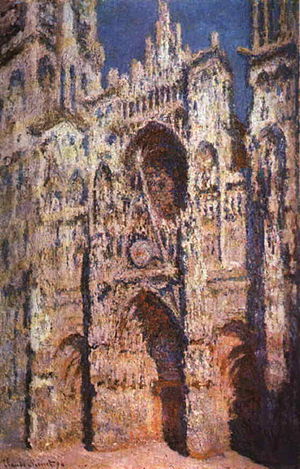“That reminds me of French Impressionism in the late 1800’s.”
“What are you talking about?” said my future client.
“In the second half of the 19th century,” I continued, “the annual Paris Salons controlled the commercial art world. If you didn’t go to the academy and paint in the traditional romantic style, you couldn’t get an exhibition at the Salon. The Realists were the first to upset the institutional apple cart, by painting real people doing real things. They painted moles and goiters and missing teeth. The Academy, the establishment, hated it. Then photography came along and photographers had the inside track on realism. Painters began to experiment with light and color. Monet and the rest painted a swirl of messy smudges and dots, and when you stepped back a few feet, voila it was the cathedral at Rouen, painted in the morning light, or in the fog, or at sunset. Impressionism was born and perhaps to prove it’s fruitfulness, Monet painted the same cathedral from the same perspective, but in different light, more than thirty times.”
“Your firm is like Monet. Technology, like the first cameras, has made an entire market less relevant. What used to be an art is now machine made. But that has opened up a new niche for tailoring product, and your company is the first to make the shift. Your prototypes are like Monet in Rouen. You’re experimenting and the early adopters are finding you.”
“Oh,” says my client. “When did you get interested in French Impressionism?”
“I lived in Paris for a while.”
“My husband and I visited Paris last year. We took a lot of pictures. We love photography. Man Ray is one of my heroes. I loved Degas’ paintings of the ballet dancers in the Musee D’Orsay. I’m happy you’ve associated us with the Impressionists. That’s a description of our industry niche that I’ll use with my investors. Thanks.”
“You’re welcome.”
Does this sound like a sales conversation to you? If it doesn’t it should. A good sales conversation, like any good conversation, is interesting. And analogy makes conversation more interesting.
An analogy is a comparison between two things, typically on the basis of their structure and usually for the purpose of explanation or clarification.
Here’s why analogy is valuable…
1. Analogize, and you illustrate for your client that you have a brain in your head and can make connections that aren’t just linear. You show your capacity for creative thinking; a trait most clients want in the salespeople who represent them.
2. Analogy is a form of disclosure. And disclosure invites disclosure. You now know more about your client; Paris visit, photography, Man Ray, Degas. You have lots of opportunities to get in touch again, like when their city’s art museum has a Degas or Man Ray exhibition.
3. Your client knows more about you. You’re not just some business robot. You are an interesting person, who might be fun to hang out with.
4. The analogy you offered could be useful when they think about their business or talk about it to stakeholders.
Analogy and Sales. They go together.
Happy Analogizing.
The ideas for this post come from my book Never Be Closing.
Tags: conversation, informal conversations, mixing business and personal, sales and analogy, small talk